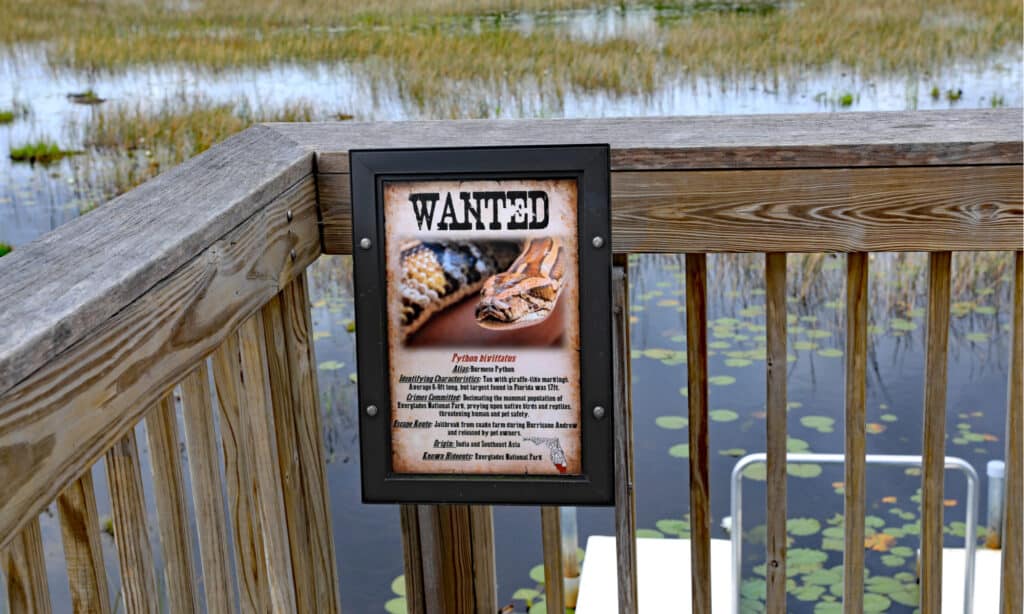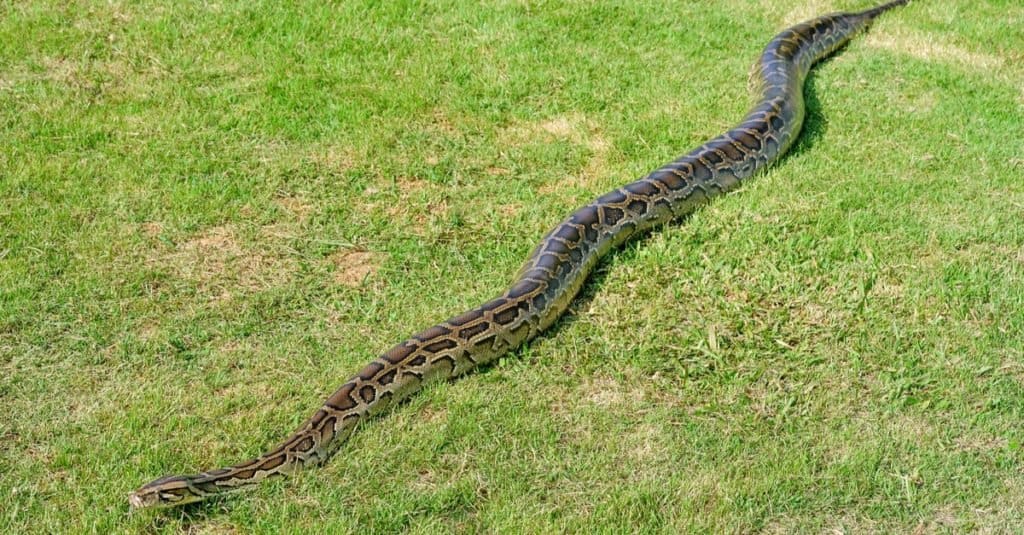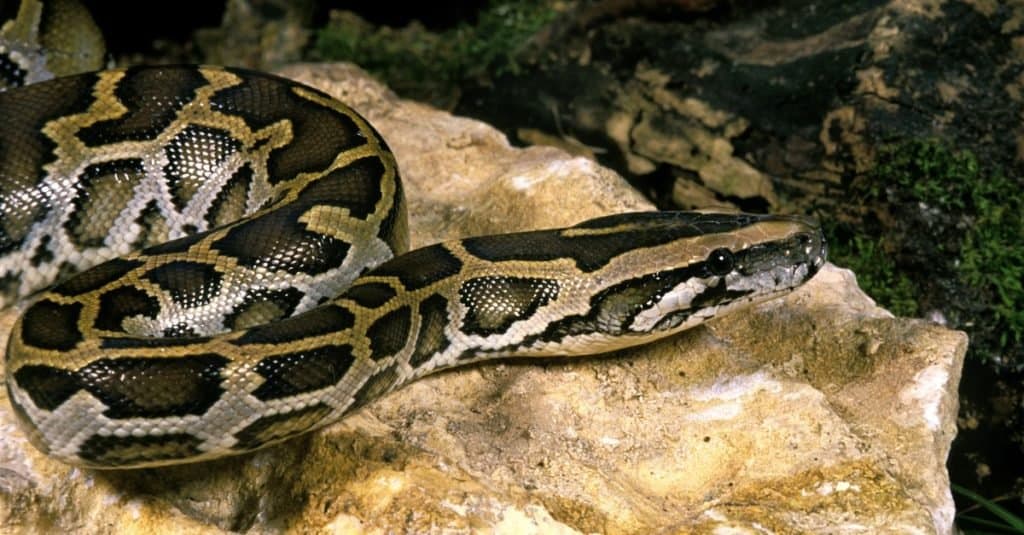Why “Hybrid Pythons” Could Be Florida’s Most Deadly Invasive Snakes
#mobileSnakeQuizControls { overflow: hidden; text-overflow: ellipsis; white-space: nowrap; }
@media (min-width: 481px) {
.mobile-top-content {
display: none;
}
}
#mobileTopContentCTACarouselControls { overflow: hidden; text-overflow: ellipsis; white-space: nowrap; }
.mobile-top-content .more { color: #fff; }
.mobile-top-content a { color: #fff; text-decoration: underline; }
.mobile-top-content a:hover { color: #fff; text-decoration: underline; }
@media (max-width: 480px) {
.mobile-top-content {
background-color: #06a10b;
color: #fff;
text-align: center;
/*height: 60px;
padding-top:5px;*/
font-size:80%;
/* display: block; */
margin: 0px -30px;
}
}
Florida has a difficult history with pythons, to say the least.
Over the last 40 years, invasive Burmese pythons have invaded the Florida Everglades. They eat everything in their path, and threaten the delicate balance of Florida’s biodiverse ecosystem. In 2018, researchers published a landmark study in the journal Ecology and Evolution proving there’s more to Florida’s invasive pythons than meets the eye. Their study suggests that the hybridization of Burmese and Indian Rock pythons has led to an even deadlier invasive python species loose in Florida.
Let’s take a look at the origins of Florida’s problem pythons. We’ll learn why invasive snakes are such a big deal in the Everglades. Then, we’ll explore exactly why Florida’s hybrid pythons are so deadly.
button.pulse {
transform: scale(1); animation: pulse 2s infinite;
box-shadow: 0 0 0 0 rgba(11, 247, 25, 1);
}
@keyframes pulse {
0% { transform: scale(0.90); box-shadow: 0 0 0 0 rgba(11, 247, 25, 0.5); }
60% { transform: scale(1); box-shadow: 0 0 0 15px rgba(11, 247, 25, 0); }
100% { transform: scale(0.90); box-shadow: 0 0 0 0 rgba(11, 247, 25, 0); }
}
The History of Pythons in Florida

Thomas Barrat/Shutterstock.com
Beginning in the 1980’s, irresponsible herpetological enthusiasts in Florida found a novel way to get rid of their unwanted Burmese pythons. They simply dumped them in the Florida Everglades. For the owners, the problem of what to do with snakes that had grown too big to handle was solved. But for the state of Florida, the problem had only just begun.
Almost immediately upon release, the newly freed Burmese pythons started living, and hunting, in a brand new ecosystem that had never seen such a giant, apex predator before. Though there are no pythons native to the United States, and the Burmese pythons had never lived in a place quite like the Florida Everglades, they soon found the area, and the prey, to their liking.
For perspective on just how out of balance the Burmese python is, captured individuals in the Everglades have measured nearly 19 feet in length while the next largest snake in the United States is the eastern indigo which measures up to 8.5 feet in length.
Within a few decades of release, invasive pythons had devoured just about every living mammal in their new home. Today, wildlife officials estimate that Florida’s invasive pythons have eliminated up to 99% of the furred creatures that once called the Everglades home.
Today, there are more pythons than ever. But, are these pythons pure Burmese pythons, or some strange hybrid?
Why Are Pythons Such a Dangerous Invasive Species?

Yatra/Shutterstock.com
You might think that releasing one little snake isn’t that big of a deal. But, consider that Burmese pythons are apex predators in their native Southeast Asia, and that the Florida Everglades present the perfect environment for them. When you take these factors into account, it’s easy to see why only a handful of pythons released decades ago has exploded into a barely controlled population of deadly invasive snakes.
Invasive species are devastating to local environments for several reasons. First, Burmese pythons have no natural predators in the Florida Everglades. This means they’ve bred an grown without threat for decades. Second, the animals that live in the Florida Everglades have not evolved to evade pythons—they’re simply not equipped to defend themselves against giant Old World pythons.
Because of this, invasive snakes threaten the natural biodiversity of Florida’s ecosystems. Scientists have recorded a catastrophic drop in the populations of small mammals in the Florida Everglades since Burmese pythons started hunting and living there in the 1980’s.
What Are Hybrid Pythons?

slowmotiongli/Shutterstock.com
As if invasive, seemingly unstoppable, Burmese pythons weren’t enough, scientists recently found that Florida’s problem snakes are even better adapted to survive than previously thought. A 2018 study published in Ecology and Evolution concluded that roughly 3% of the 400 wild Burmese pythons sampled contained DNA markers for a totally different species of snake. That snake is the Indian rock python, a smaller, quicker relative of the Burmese python.
The scientists involved in the study estimate that the hybridization occurred long before people released the snakes into the wild. It’s likely that these Burmese-Indian Rock hybrids have been living in Florida all along. Their presence just might be the key to this invasive snake’s success in the Everglades.
Why Are Hybrid Pythons a Big Deal?
According to the study, Florida’s hybrid pythons have a large genetic base comprised of distinct lineages. This gives the invasive pythons an edge over their non-hybridized brethren. They’re better suited to thrive in a wide range of habitats than non-hybridized Burmese pythons. This makes them even more of a threat to Florida’s biodiversity.
Each species has its own strengths and habitat preferences, so when you combine them, it’s a little like taking the strengths of each species, and putting them into one snake. Hybridized pythons can survive, and thrive, in a wider range of habitats than non-hybridized pythons. And, they may be better hunters too, since they can target a greater variety of prey. In recent years, Florida’s hybrid pythons have even started eating alligators, since they’ve so thoroughly decimated the Everglades’ mammal population.
Will Florida Ever Be Python Free Again?

Heiko Kiera/Shutterstock.com
According to wildlife biologists, it’s highly unlikely that Florida will ever be rid of its invasive snakes, hybrid or otherwise. The reason for this is that the hybrid pythons now live across 1,000 square miles of the Florida Everglades and estimates of their population top 100,000 snakes. That’s a lot of ground to cover for extermination.
But, more than that, the hybrid pythons are cryptic, which means they’re very good at hiding from humans. It might be hard to believe that such large creatures can avoid detection, but the Everglades provide the perfect, semi-aquatic hiding places for these big snakes. Couple that with the fact that Florida’s hybrid snakes have now been living, and breeding, for four decades, and you have a problem that just won’t go away.
Scientists and land managers know that they’ll never be rid of Florida’s pythons. So instead they focus their efforts on managing the present population. This means that their efforts go towards ensuring that the population doesn’t grow, and also that it doesn’t spread. To accomplish this, wildlife biologists encourage private land owners to kill pythons on sight—no license needed. They also closely monitor snake populations, and support studies like the 2018 hybrid python study. In so doing, they can better understand the invasive snakes they’re stuck with.
Discover the “Monster” Snake 5X Bigger than an Anaconda
Every day A-Z Animals sends out some of the most incredible facts in the world from our free newsletter. Want to discover the 10 most beautiful snakes in the world, a “snake island” where you’re never more than 3 feet from danger, or a “monster” snake 5X larger than an anaconda? Then sign up right now and you’ll start receiving our daily newsletter absolutely free.
More from A-Z Animals
.more-snake-card-image { max-height:140px !important; }
#mobileSnakeQuizControls { overflow: hidden; text-overflow: ellipsis; white-space: nowrap; }
@media (min-width: 481px) {
.mobile-top-content {
display: none;
}
}
#mobileTopContentCTACarouselControls { overflow: hidden; text-overflow: ellipsis; white-space: nowrap; }
.mobile-top-content .more { color: #fff; }
.mobile-top-content a { color: #fff; text-decoration: underline; }
.mobile-top-content a:hover { color: #fff; text-decoration: underline; }
@media (max-width: 480px) {
.mobile-top-content {
background-color: #06a10b;
color: #fff;
text-align: center;
/*height: 60px;
padding-top:5px;*/
font-size:80%;
/* display: block; */
margin: 0px -30px;
}
}
Florida has a difficult history with pythons, to say the least.
Over the last 40 years, invasive Burmese pythons have invaded the Florida Everglades. They eat everything in their path, and threaten the delicate balance of Florida’s biodiverse ecosystem. In 2018, researchers published a landmark study in the journal Ecology and Evolution proving there’s more to Florida’s invasive pythons than meets the eye. Their study suggests that the hybridization of Burmese and Indian Rock pythons has led to an even deadlier invasive python species loose in Florida.
Let’s take a look at the origins of Florida’s problem pythons. We’ll learn why invasive snakes are such a big deal in the Everglades. Then, we’ll explore exactly why Florida’s hybrid pythons are so deadly.
button.pulse {
transform: scale(1); animation: pulse 2s infinite;
box-shadow: 0 0 0 0 rgba(11, 247, 25, 1);
}
@keyframes pulse {
0% { transform: scale(0.90); box-shadow: 0 0 0 0 rgba(11, 247, 25, 0.5); }
60% { transform: scale(1); box-shadow: 0 0 0 15px rgba(11, 247, 25, 0); }
100% { transform: scale(0.90); box-shadow: 0 0 0 0 rgba(11, 247, 25, 0); }
}
The History of Pythons in Florida

Thomas Barrat/Shutterstock.com
Beginning in the 1980’s, irresponsible herpetological enthusiasts in Florida found a novel way to get rid of their unwanted Burmese pythons. They simply dumped them in the Florida Everglades. For the owners, the problem of what to do with snakes that had grown too big to handle was solved. But for the state of Florida, the problem had only just begun.
Almost immediately upon release, the newly freed Burmese pythons started living, and hunting, in a brand new ecosystem that had never seen such a giant, apex predator before. Though there are no pythons native to the United States, and the Burmese pythons had never lived in a place quite like the Florida Everglades, they soon found the area, and the prey, to their liking.
For perspective on just how out of balance the Burmese python is, captured individuals in the Everglades have measured nearly 19 feet in length while the next largest snake in the United States is the eastern indigo which measures up to 8.5 feet in length.
Within a few decades of release, invasive pythons had devoured just about every living mammal in their new home. Today, wildlife officials estimate that Florida’s invasive pythons have eliminated up to 99% of the furred creatures that once called the Everglades home.
Today, there are more pythons than ever. But, are these pythons pure Burmese pythons, or some strange hybrid?
Why Are Pythons Such a Dangerous Invasive Species?

Yatra/Shutterstock.com
You might think that releasing one little snake isn’t that big of a deal. But, consider that Burmese pythons are apex predators in their native Southeast Asia, and that the Florida Everglades present the perfect environment for them. When you take these factors into account, it’s easy to see why only a handful of pythons released decades ago has exploded into a barely controlled population of deadly invasive snakes.
Invasive species are devastating to local environments for several reasons. First, Burmese pythons have no natural predators in the Florida Everglades. This means they’ve bred an grown without threat for decades. Second, the animals that live in the Florida Everglades have not evolved to evade pythons—they’re simply not equipped to defend themselves against giant Old World pythons.
Because of this, invasive snakes threaten the natural biodiversity of Florida’s ecosystems. Scientists have recorded a catastrophic drop in the populations of small mammals in the Florida Everglades since Burmese pythons started hunting and living there in the 1980’s.
What Are Hybrid Pythons?

slowmotiongli/Shutterstock.com
As if invasive, seemingly unstoppable, Burmese pythons weren’t enough, scientists recently found that Florida’s problem snakes are even better adapted to survive than previously thought. A 2018 study published in Ecology and Evolution concluded that roughly 3% of the 400 wild Burmese pythons sampled contained DNA markers for a totally different species of snake. That snake is the Indian rock python, a smaller, quicker relative of the Burmese python.
The scientists involved in the study estimate that the hybridization occurred long before people released the snakes into the wild. It’s likely that these Burmese-Indian Rock hybrids have been living in Florida all along. Their presence just might be the key to this invasive snake’s success in the Everglades.
Why Are Hybrid Pythons a Big Deal?
According to the study, Florida’s hybrid pythons have a large genetic base comprised of distinct lineages. This gives the invasive pythons an edge over their non-hybridized brethren. They’re better suited to thrive in a wide range of habitats than non-hybridized Burmese pythons. This makes them even more of a threat to Florida’s biodiversity.
Each species has its own strengths and habitat preferences, so when you combine them, it’s a little like taking the strengths of each species, and putting them into one snake. Hybridized pythons can survive, and thrive, in a wider range of habitats than non-hybridized pythons. And, they may be better hunters too, since they can target a greater variety of prey. In recent years, Florida’s hybrid pythons have even started eating alligators, since they’ve so thoroughly decimated the Everglades’ mammal population.
Will Florida Ever Be Python Free Again?

Heiko Kiera/Shutterstock.com
According to wildlife biologists, it’s highly unlikely that Florida will ever be rid of its invasive snakes, hybrid or otherwise. The reason for this is that the hybrid pythons now live across 1,000 square miles of the Florida Everglades and estimates of their population top 100,000 snakes. That’s a lot of ground to cover for extermination.
But, more than that, the hybrid pythons are cryptic, which means they’re very good at hiding from humans. It might be hard to believe that such large creatures can avoid detection, but the Everglades provide the perfect, semi-aquatic hiding places for these big snakes. Couple that with the fact that Florida’s hybrid snakes have now been living, and breeding, for four decades, and you have a problem that just won’t go away.
Scientists and land managers know that they’ll never be rid of Florida’s pythons. So instead they focus their efforts on managing the present population. This means that their efforts go towards ensuring that the population doesn’t grow, and also that it doesn’t spread. To accomplish this, wildlife biologists encourage private land owners to kill pythons on sight—no license needed. They also closely monitor snake populations, and support studies like the 2018 hybrid python study. In so doing, they can better understand the invasive snakes they’re stuck with.
Discover the “Monster” Snake 5X Bigger than an Anaconda
Every day A-Z Animals sends out some of the most incredible facts in the world from our free newsletter. Want to discover the 10 most beautiful snakes in the world, a “snake island” where you’re never more than 3 feet from danger, or a “monster” snake 5X larger than an anaconda? Then sign up right now and you’ll start receiving our daily newsletter absolutely free.







